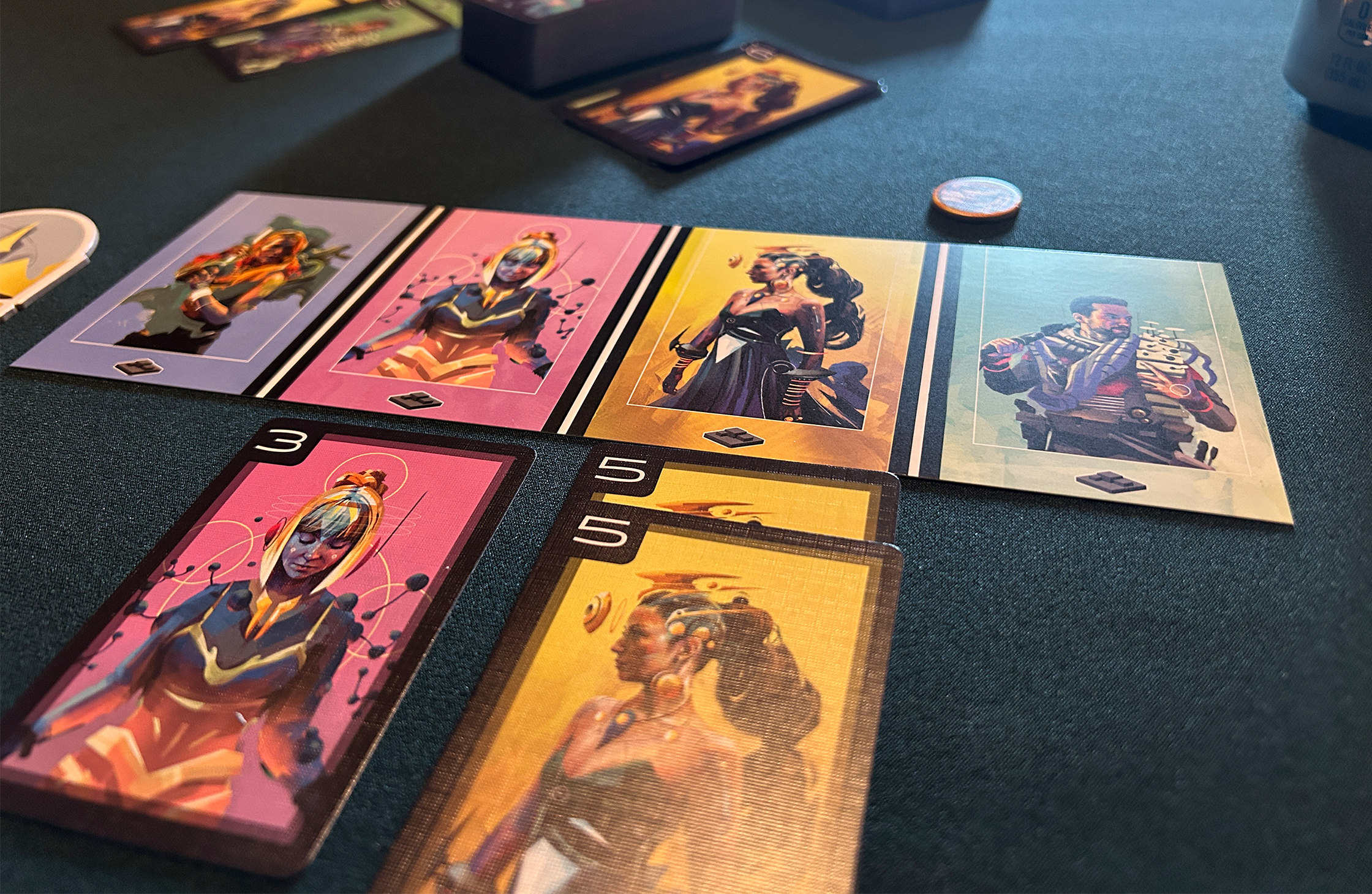There are a handful of games that are way, way better than they have any right to be from just the description; this is one of them. Capital Lux 2: Generations (Lux) combines a little bit of push your luck, a little bit of influence control, a little bit of hand drafting, and a whole lot of variability and emergent strategy. There’s a theme in there too, but don’t worry too much about that. Let’s dive in. (Oh, and don’t worry about the “2” in the title; there’s no need to have the original version of this game.)
To set up, give each player a Home Base sheet and place the Capitol sheet in the middle of the table between all players. You’ll notice that both the Capitol and Home Base sheets are divided into four colored segments: blue, pink, yellow, and green. These colors represent the different factions you’ll be contributing to as you’re playing. Next, draw one power token for each of the factions, and place it on the corresponding Capitol sheet space. Put the Gold Coin tokens near the Capitol sheet. Deal six Citizen cards to each player, have each choose two and pass the remaining to the player on their left, choose another two, pass the remaining to the left again, and continue until every player has a hand of six cards. Choose a starting player, and start playing.
Citizen cards are all similar — they have a faction color and a numeric value. During each turn, a player can perform one of two actions: they can play a card down into their Home Base, or they can play a card into the Capitol. Playing a card down into their Home Base will contribute to scoring (more on that in a bit). Playing a card down into the Capitol also indirectly contributes to scoring, but more importantly, allows the active player to make use of a faction’s power.
The most important bit about scoring is this: at the end of a round, if the total value of cards in any given faction in a player’s Home Base is greater than the total value of cards in the Capitol for that faction, that player discards all cards in their Home Base for that faction, scoring nothing. This is the give and take that forms a large part of the strategy of card playing — do you play a card down into your Home Base in the hopes that you’ll be able to score it at the end of the round, or do you add it to the Capitol, making it easier for your opponents to add cards to their Home Bases?
And here’s the thing about faction powers: they’re all extremely different game to game. When you perform setup, you’ll notice that there are a bunch of extra components that aren’t brought in — additional decks, different tokens, another sideboard with rocket ships, etc. Whether or not these items are used is based entirely on the power tokens drawn during setup. Blue powers favor manipulating Capitol and Home Base factions by adding new decks into the game. Pink powers can discard cards en masse from Capitol factions, or add alternative actions to a player’s turn. Yellow powers introduce new methods of using Gold Coin tokens aside from their basic 2 Victory Point value. Green powers can add cards from your hand, introduce Citizen cards with multiple colors, or bring in a Space exploration mechanism that adds a mini-game to the base.
The best part about these powers is that since everyone has complete access to them at all times, they don’t have to be in balance with one another. Players that can suss out strategies to leverage these powers when placing their cards will do incredibly well, but since there are 256 power combinations in the base game (the expansion increases this to 1024), finding a winning strategy in one game won’t necessarily help a player in the next. And again, these powers are very different. I’ve played Lux over 15 times at this point, and every game feels entirely fresh.
For scoring, as soon as one player runs out of cards, each player has one more turn to place a card from their hand as they wish. All remaining cards in their hand are placed into their Home Base (which could potentially push that faction’s total over the Capitol’s threshold). Once everyone’s hands are empty, compare Home Base faction totals to Capitol faction totals, and discard all Home Base factions that exceed the Capitol factions. Then, for each faction, the player with the highest total value takes the highest valued card from the matching Capitol faction and places it into a Bonus Card pile next to their Home Base. These piles will be scored at the end of the game. Once all factions are resolved, deal out six more Citizen cards, draft them, and play another round.
After the third round is resolved, a player’s final score is determined by adding up all cards in their Home Base, all cards in their Bonus Card pile, coins at 2 points each, and any other scoring condition introduced by a faction power. Whoever has the most points wins.
My only criticism of the game is the component quality. I would have loved to see the card quality improved, and having proper boards for the Home Base and the Capitol instead of the card stock sheets used would have been well received. Also, the sheets are just a hair larger than the box dimensions, so putting them underneath the components leads to an extremely challenging time trying to get them out. Same goes for the rulesheets. I’ve folded my rulesheets in half, and have cut down the Home Base and Capitol sheets very slightly for a better fit. I also ended up sleeving all of my cards, and 3D printed an insert to help with setup and storing. The chip board for the tokens is good, and the graphic design features iconography that is easy to follow and remember.
Gamewise, though? This is one of my favorites, and definitely my top game to teach new players at game nights these days. It’s easy to quickly learn the basics, has a satisfying play time, there is significant room for player skill improvement and exploration, and it plays well at all player counts (although I can’t speak to the solo play yet, as I haven’t had the occasion to try it; however, it does look extremely promising). If you can find a copy of this, buy it immediately and order the expansion.
Designed by: Kristian Amundsen Østby, Eilif Svensson
Player Count: 1–4 (5 with the expansion)
Playtime: 30 minutes
Time to Learn: 5 minutes
Complexity: 2.0
Replayability: 5/5
MSRP: $30
Written by Brendan Quinn, President of Tri-City Area Gaming. We’re out in the world again! Come play games with us at any of our regular monthly events.
All the links for Tri-City Area Gaming: tcag.carrd.co


